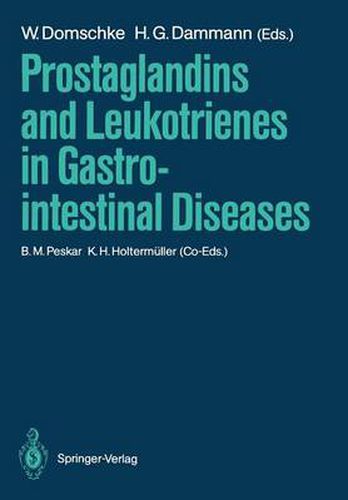Readings Newsletter
Become a Readings Member to make your shopping experience even easier.
Sign in or sign up for free!
You’re not far away from qualifying for FREE standard shipping within Australia
You’ve qualified for FREE standard shipping within Australia
The cart is loading…






This title is printed to order. This book may have been self-published. If so, we cannot guarantee the quality of the content. In the main most books will have gone through the editing process however some may not. We therefore suggest that you be aware of this before ordering this book. If in doubt check either the author or publisher’s details as we are unable to accept any returns unless they are faulty. Please contact us if you have any questions.
In OCtober 1986, recognized authorities from a variety of disciplines met in Lisbon, Portugal, to review recent knowledge on eicosanoids - i. e., prostaglandins, throm boxane A , and leukotrienes - and their role in gastrointestinal diseases. 2 Briefly, in the stomach endogenous as well as exogenous prostaglandins may mediate cytoprotective actions in that they stimulate gastric mucus production, bicar bonate secretion and cellular regeneration while providing adequate mucosal blood flow. In contrast, thromboxane A2 by vasoconstriction may act as an ulcerogenic substance. Diarrheal states may be associated with prostaglandins of types E and F as they are capable to enhance intestinal water and electrolyte secretions. In chronic in flammatory bowel disease, mucosal synthesis of leukotrienes was found to be increased more markedly than that of prostaglandins suggesting that leukotrienes may have a major part in the pathogenesis of that disease. In this volume, which is an elaborated collection of the papers given on occasion of the above-mentioned symposium, the facts and problems associated with prostanoid substances are dealt with in four sections on 1. biochemistry, biology and pharmacology of eicosanoids, 2. physiologic and pathophysiologic aspects, 3. established therapeutic implications, and 4. treatment perspectives. We believe that the publication of these contributions by leading workers in the given fields provides a comprehensive and up-to-date appraisal of the role of eicosanoids in gastrointestinal diseases, and it is hoped that this volume will be of value to both basic scientists and practicing clinicians.
$9.00 standard shipping within Australia
FREE standard shipping within Australia for orders over $100.00
Express & International shipping calculated at checkout
This title is printed to order. This book may have been self-published. If so, we cannot guarantee the quality of the content. In the main most books will have gone through the editing process however some may not. We therefore suggest that you be aware of this before ordering this book. If in doubt check either the author or publisher’s details as we are unable to accept any returns unless they are faulty. Please contact us if you have any questions.
In OCtober 1986, recognized authorities from a variety of disciplines met in Lisbon, Portugal, to review recent knowledge on eicosanoids - i. e., prostaglandins, throm boxane A , and leukotrienes - and their role in gastrointestinal diseases. 2 Briefly, in the stomach endogenous as well as exogenous prostaglandins may mediate cytoprotective actions in that they stimulate gastric mucus production, bicar bonate secretion and cellular regeneration while providing adequate mucosal blood flow. In contrast, thromboxane A2 by vasoconstriction may act as an ulcerogenic substance. Diarrheal states may be associated with prostaglandins of types E and F as they are capable to enhance intestinal water and electrolyte secretions. In chronic in flammatory bowel disease, mucosal synthesis of leukotrienes was found to be increased more markedly than that of prostaglandins suggesting that leukotrienes may have a major part in the pathogenesis of that disease. In this volume, which is an elaborated collection of the papers given on occasion of the above-mentioned symposium, the facts and problems associated with prostanoid substances are dealt with in four sections on 1. biochemistry, biology and pharmacology of eicosanoids, 2. physiologic and pathophysiologic aspects, 3. established therapeutic implications, and 4. treatment perspectives. We believe that the publication of these contributions by leading workers in the given fields provides a comprehensive and up-to-date appraisal of the role of eicosanoids in gastrointestinal diseases, and it is hoped that this volume will be of value to both basic scientists and practicing clinicians.